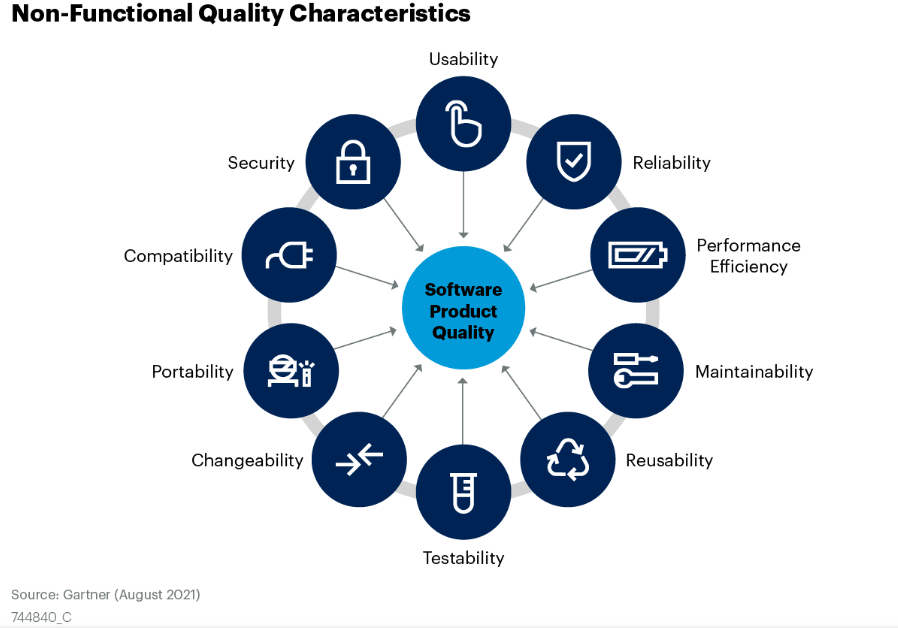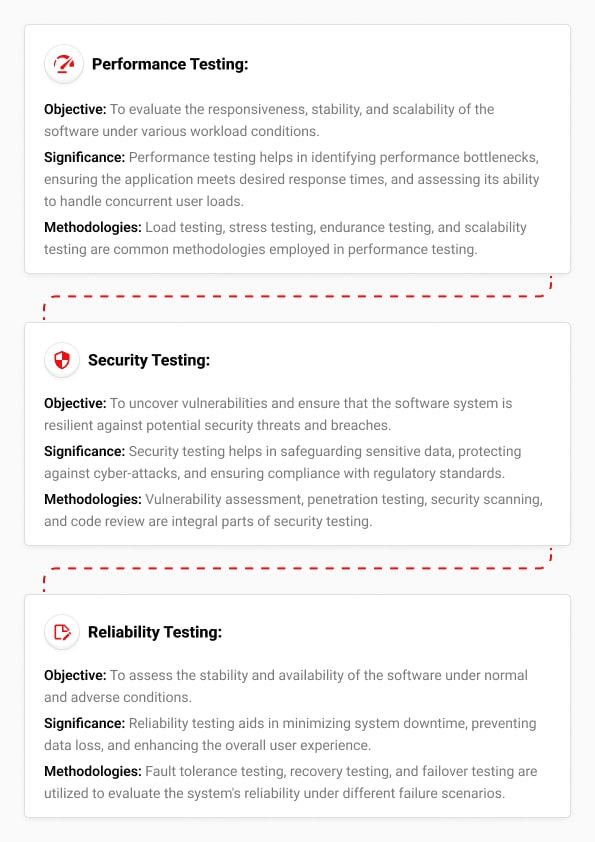In software testing development, achieving success extends beyond functional capabilities; it encompasses a broader spectrum of characteristics that define the software’s quality. These go beyond the standard operations a program performs and delve into the non functional quality characteristics aspects that impact user experience and overall performance.
According to the 2022 Gartner Software Engineering Survey, a significant 56% of software engineering leaders recognize a current gap in quality and testing skills within their organizations. This underscores the importance of addressing non functional quality characteristics to enhance software quality and overall user satisfaction. In response to these findings, software engineering leaders can leverage this research as a blueprint for implementing a robust quality assurance (QA) framework that prioritizes nonfunctional characteristics, with a special emphasis on maintainability. Particularly in agile methodologies, the nonfunctional requirements can be seamlessly integrated into the definitions of done, ensuring that software is deemed ready for deployment.

Core Objectives of Non-Functional Testing
Non-functional testing plays a pivotal role in validating critical aspects of a software system beyond its primary functionalities. From performance to security, non-functional testing encompasses a diverse range of objectives aimed at enhancing the overall quality and reliability of software products.

Usability Testing
Objective: To gauge the user-friendliness and intuitiveness of the software interface.
Significance: Usability testing focuses on enhancing user satisfaction, improving user adoption rates, and reducing training efforts.
Methodologies: User surveys, heuristic evaluations, and usability testing sessions help in gathering feedback on the software’s usability aspects.
Scalability Testing
Objective: To assess the software’s ability to accommodate increased workload and scale resources efficiently.
Significance: Scalability testing ensures that the application can handle growing user demands without compromising performance or reliability.
Methodologies: Horizontal scaling tests, vertical scaling tests, and capacity planning exercises are conducted to evaluate the system’s scalability capabilities.
Compatibility Testing
Objective: To verify the software’s compatibility with different operating systems, browsers, devices, and network environments.
Significance: Compatibility testing ensures seamless user experiences across diverse platforms, mitigating compatibility-related issues.
Methodologies: Cross-browser testing, cross-platform testing, and interoperability testing help in assessing compatibility aspects.
Portability Testing
Objective: Portability testing aims to assess the ease with which a software system can be transferred or deployed across different environments, including different operating systems, hardware platforms, or cloud infrastructures.
Significance: Portability testing ensures that the software can adapt and function effectively in diverse environments, enhancing its flexibility and accessibility to users across different platforms. It reduces dependency on specific hardware or software configurations, thereby increasing the software’s reach and usability.
Methodologies: Portability testing involves conducting compatibility tests across various operating systems, hardware platforms, and environments to ensure seamless functionality.
Maintainability Testing
Objective: To evaluate the ease of maintaining and modifying the software codebase.
Significance: Maintainability testing facilitates efficient software maintenance, reduces technical debt, and enhances code quality.
Methodologies: Code complexity analysis, code refactoring assessments, and testability evaluations are employed to assess maintainability.
Key Benefits of Non Functional Quality Characteristics in Testing
Implementing a holistic quality strategy that encompasses nonfunctional quality characteristics offers several key benefits:
- Mitigation of Business Risk and Customer Impact: By addressing non functional quality characteristics requirements, businesses can proactively mitigate risks and minimize the potential impact on customers, thereby ensuring a more stable and reliable software environment.
- Enhanced Release Confidence: Focusing on nonfunctional aspects strengthens confidence in software releases, providing valuable insights into technology performance, resilience, and user experience in real-world production environments.
- Accelerated Fault Detection and Resolution: Non functional quality characteristics requirements are instrumental in swiftly identifying and resolving complex issues that may not be rooted in functional defects. This accelerates the troubleshooting process, enhancing overall software reliability.
- Improved Agility in Implementing Changes: A comprehensive quality strategy, inclusive of nonfunctional characteristics, facilitates the swift and cost-effective delivery of changes required by the business. This agility is crucial in supporting business efficiency, growth, and transformation targets.
Overview of the 9 Non Functional Quality Characteristics
Non functional quality characteristics, also known as non-functional requirements or quality attributes, are essential aspects of software that go beyond its basic functionality. These characteristics play a crucial role in determining the overall quality, performance, and user experience of a software system.
- Performance: Performance refers to how efficiently a software system responds to user interactions and handles workload demands. It encompasses factors such as response time, throughput, and resource utilization. A high-performance system ensures smooth and responsive user experiences, even under heavy loads.
- Reliability: Reliability measures the ability of a software system to perform consistently and predictably under normal and adverse conditions. It ensures minimal downtime and data loss, thereby instilling confidence in users regarding the system’s stability and dependability.
- Scalability: Scalability evaluates a software system’s ability to handle increasing workload demands by efficiently utilizing resources and maintaining performance levels as the workload grows. A scalable system can accommodate growth without sacrificing performance or user experience.
- Maintainability: Maintainability refers to how easily a software system can be modified, updated, and maintained over its lifecycle. It includes attributes such as code readability, modularity, and documentation. A maintainable system reduces the cost and effort required for ongoing maintenance and enhancements.
- Security: Security ensures that a software system is protected against unauthorized access, data breaches, and other security threats. It involves implementing measures to safeguard data confidentiality, integrity, and availability, thereby preserving the trust and privacy of users.
- Usability: Usability evaluates how user-friendly and intuitive a software system is, measuring factors such as ease of use, learnability, and efficiency of user interactions. A highly usable system enhances user satisfaction, productivity, and adoption rates.
- Portability: Portability assesses the ease with which a software system can be transferred or deployed across different environments, including different operating systems, hardware platforms, or cloud infrastructures. It ensures flexibility and accessibility across diverse platforms and environments.
- Compatibility: Compatibility ensures that a software system functions correctly and seamlessly with other systems, applications, and environments. It involves testing across various browsers, devices, and network configurations to ensure broad compatibility and interoperability.
- Compliance: Compliance involves adhering to legal, regulatory, and industry standards and requirements relevant to the software system. ICompliance testing ensures legal and regulatory obligations are met, reducing legal risks and maintaining user trust.
As technology continues to evolve, software engineers and developers must prioritize not only functional requirements but also these crucial non-functional dimensions. Embracing the significance of these non-functional attributes is not just a best practice; it is an essential strategy for fostering innovation, building trust with users, and ultimately propelling the software industry forward into a future defined by excellence and user-centricity.
Evolving Landscape of Non-functional Quality Characteristics in Software Development
The landscape of non-functional software quality is evolving rapidly, driven by advancements in technology, changing user expectations, and increasing demands for reliability, performance, security, and usability.
Focus on Performance Optimization: With the proliferation of digital services and applications, there’s an increased emphasis on optimizing performance to deliver faster response times, higher throughput, and better resource utilization. Technologies like cloud computing, edge computing, and content delivery networks (CDNs) are being leveraged to enhance performance and scalability.
Rising Importance of Security: Cybersecurity threats continue to pose significant risks to software systems and data integrity. As a result, there’s a growing emphasis on incorporating robust security measures into software development processes. This includes adopting secure coding practices, implementing encryption, authentication, and access control mechanisms, and conducting regular security audits and penetration testing.
Shift towards User-Centric Design: Usability and user experience (UX) have become critical differentiators in today’s competitive software market. There’s a shift towards user-centric design principles, focusing on creating intuitive interfaces, simplifying workflows, and enhancing overall user satisfaction.
Scalability for Growing Workloads: As user bases and data volumes continue to grow, scalability becomes paramount for software systems to accommodate increasing workload demands. Scalability testing and architecture design patterns such as microservices, serverless computing, and horizontal scaling are adopted to ensure systems can scale efficiently while maintaining performance and reliability.
Emphasis on Maintainability and Agility: Agile methodologies and DevOps practices are gaining traction to enable rapid development, deployment, and iteration of software systems. Maintainability becomes crucial for facilitating ongoing updates, enhancements, and bug fixes without introducing technical debt or disrupting system stability.
Cross-Platform Compatibility: Software systems need to function seamlessly across various operating systems, browsers, devices, and screen sizes. Compatibility testing and responsive design principles are employed to deliver consistent user experiences across diverse platforms and environments.
Regulatory Compliance and Data Privacy: Stricter regulatory frameworks and data privacy regulations, such as GDPR, CCPA, and HIPAA, impose legal obligations on organizations to protect user data and ensure compliance with industry standards. Compliance testing and adherence to privacy-by-design principles are essential to mitigate legal risks and maintain trust with users.
From performance optimization to security fortification, usability enhancement to compliance adherence, each characteristic plays a vital role in shaping the user experience, safeguarding data integrity, and maintaining system resilience. Moreover, as user expectations continue to evolve and cybersecurity threats loom large, prioritizing non functional quality characteristics is becoming imperative for organizations striving to deliver software solutions that not only meet functional requirements but also excel in terms of performance, reliability, security, usability, scalability, maintainability, compatibility, portability, and compliance.

